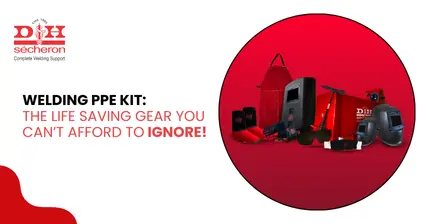From many welding materials in the industry. Welding Hard Steel was easy if practiced well enough, but the final welded product of steel came with its own set of challenges, corrosion being the primary reason.
With developments in the metallurgical industry, low alloy steel was brought into the picture.
Stainless Steel (SS) an alloy discovered in the 1800s was a revolutionary alloy with many uses, primarily used in industrial equipment when long-lasting durability of the equipment was a priority that could be easily cleaned and the performance has been improved in many new ways
Stainless Steel is far more corrosion-resistant than standard carbon steel, popularly known for its enhanced durability, corrosion resistance & high-temperature oxidation resistance.
Coming along in various material types, the special properties of stainless steel were brought out by the simple addition of alloying elements like nickel and chromium to steel.
The formula is that more than 10% chromium is required to produce a stainless iron. Stainless steel has 4 grades which are further classified depending on the welding requirements, welding characteristics, microstructure (the key influencing factor in how strong the steel is going to be) and material strength.
Austenitic Stainless Steel: Single-phase, which is very commonly used to create stainless steel welding rods.
Ferritic Stainless Steel: Single phase, commonly used as they are cheap to manufacture.
Martensitic Stainless Steel: Used for high wear and tear hard facing applications.
Austenitic-ferritic (duplex) Stainless Steel: Double-phase that contains both ferrite and austenite in the microstructure.
With such effective properties, why is it so hard to weld Stainless Steel?
What makes welding a bit more challenging and tedious especially for an expert welder, Stainless steel warp under high temperatures and distort the whole cooling process due to poor thermal conductivity.
The welding result does not look flawless as it displays every blemish and scratch mark that’s left behind. Correcting welding mistakes is also quite a bit of a challenge so precautions need to taken or else it would scratch very easily.
Approaches we can use in welding stainless steel.
The not-so-simple answer is, it depends on what result you’re trying to achieve.
Stainless steel can be welded with shielded metal arc welding (MIG), gas tungsten arc welding (TIG) and stick welding, and each of these processes will yield a slightly different result.
To find the best welding process for your project, consider the following factors: the welder’s skill level, the aesthetics of the final piece including bead appearance, the thickness of the metal plus the costs and timing factors of the project. If artistry is paramount, then the finesse of TIG welding could be a good fit, but if speed and efficiency are a priority, then MIG welding may be a better process.
To simply answer your query, if you're looking for a more affordable weld, spot welding might be the best option for the job. But if the material we’re working with is thin, then TIG or gas tungsten arc welding might be the better choice.
11 May 2025 | Welding
An In-Depth Exploration of Low-Alloy Steel: Your Comprehensive Guide
11 May 2025 | Welding
Nagpur - Bori - Tuljapur Road MSH-3 in Yavatmal District (Maharashtra)
11 May 2025 | Welding
Guidelines to Understand Gas Welding: Applications, Advantages & Disadvantages
11 May 2025 | Welding
3 Tips for Finding the Best Mild Steel Electrode for Your Application
11 May 2025 | Welding
How to Select the Right Welding Filler Wires for Stainless Steel Welding?
11 May 2025 | Welding
Building the Narendra Modi Stadium with Norma V and Autotherme-1 Electrodes
11 May 2025 | Welding
Low Alloy Steel Welding in a (PEB) Pre Engineered Building Structure
11 May 2025 | Welding
Welding Rods: Different Types and Tips for Properly Storing and Handling
11 May 2025 | Welding
Tips for Flawless Welds with Stainless Steel Electrodes: Pros and Cons
11 May 2025 | Welding
Exploring Applications and Benefits of Stainless Steel Welding Electrodes
11 May 2025 | Welding
Welding Basics: Joining Metals with Heat and Pressure - A Beginners Guide
11 May 2025 | Welding
Distinguishing Low-Alloy Steel from High-Alloy Steel: Understanding the Variations
11 May 2025 | Welding
Hard Facing Wire - Understanding the Process and Achieving Optimal Result
11 May 2025 | Welding
Exploring the Advantages of Stainless Steel Electrodes in Welding Applications
11 May 2025 | Welding
Weathering Steel vs. Traditional Steel: A Comparative Analysis of Performance
11 May 2025 | Welding
Choosing the Right Welding Rod: Why 6013 Electrodes Might Be Your Ideal Option
11 May 2025 | Welding
Why 7018 Electrodes Are Preferred for High-Strength Welds in Pipeline Construction
11 May 2025 | Welding
Filler Wire vs. Stainless Steel Filler Wire: Understanding the Key Differences
11 May 2025 | Welding
Exploring the Impact of Filler Material on Welding Quality and Durability
11 May 2025 | Welding
Choosing the Right Cast Iron Electrode for Different Welding Projects
11 May 2025 | Welding
Top Advantages of Cast Iron Electrodes for Industrial Welding Applications
11 May 2025 | Welding
Key Benefits and Challenges of Using TIG Welding in Industrial Projects
11 May 2025 | Welding
5 Reasons Why 7018 Electrode is the Gold Standard for Welding Professionals
11 May 2025 | Welding
Top 5 Advantages of Flux Cored Arc Welding for Heavy-Duty Applications.png)
11 May 2025 | Welding
Lotherme-601: A Game-Changer for Restoring Shoulder Pins in Heavy Machinery
11 May 2025 | Welding
How D&H Sécheron Helped Repair a Rotary Kiln’s Cooler Section with LoTherme 352
11 May 2025 | Welding
Piston Repair for Mining Industry: Cost-Effective Solutions with LoTherme 468.webp)






.jpg)







































.jpg)
.jpg)

.jpg)

.jpg)





.jpg)
.jpg)
.jpg)



.webp)
.jpg)
.jpg)
.webp)
.jpg)






















.png)



.webp)

.webp)
.webp)



